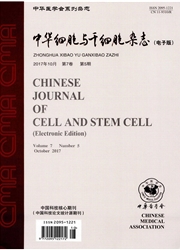

 中文摘要:
中文摘要:
目的 探讨不同激活性杀伤细胞免疫球蛋白样受体(KIR)在人类白细胞抗原(HLA)全相合无关供体异基因造血干细胞移植中的作用。方法 采用序列特异性引物聚合酶链反应(PCR-SSP)和基因测序(SBT)方法,对中国造血干细胞捐献者资料库中提供的74对HLA全相合供受者进行KIR及HLA高分辨分型,其中38例进行异基因造血干细胞移植,接受移植的患者FAB分型为急性淋巴细胞白血病(ALL)18例、慢性粒细胞白血病(CML8)例、急性髓系白血病(AML)12例,移植后的患者随访到2008年12月。结果 在74对供受者中100.00﹪有KIR2DS4基因,64.87﹪有KIR2DS1基因,60.81﹪有KIR3DS1基因,45.95﹪有KIR2DS5基因,44.60﹪有KIR2DS2基因,35.14﹪有KIR2DS3基因。在AML和CML分型的移植中供者有激活性KIR2DS1、KIR2DS3和KIR3DS1基因高表达;而在ALL分型的移植中低表达。在表达KIR2DS4的供受者中,其中51.40﹪仅表达2DS4*001/002亚型,23.60﹪仅表达2DS4*003-007亚型,25.00﹪为两种亚型同时表达。供受者仅有2DS4*001/002亚型的病例均在移植后死亡;供者具有2DS4*003-007亚型的病例1年无病生存率为83.30﹪。当供者aKIR基因数目≥3个时,ALL患者的1年无病生存率为87.50﹪;当供者aKIR基因数目〈3个时,AML/CML患者1年无病生存率为83.33﹪。结论 在无关供体异基因造血干细胞移植中,KIR单体型A、激活性KIR受体基因亚型和数目的差异表达,对降低GVHD的发生和移植的预后起关键作用。
 英文摘要:
英文摘要:
Objective To explore the impact of different activating KIRs in HLA matched unrelated allo-hematopoietic stem cell transplantation. Methods The HLA/KIR genotypes of 74 patients and their matched unrelated donors from database of CMDP were determined by PCR-SSP and SBT. 38 patients received unrelated allo-HSCT. Among them, 18 were ALL, 8 were CML and 12 were AML by FAB typing. The survival of recipients with aKIR subtyping was analyzed using Kaplan-Meier after alIo-HSCT. Results The frequencies of KIR2DS4, KIR2DS1, KIR3DS1, KIR2DS5, KIR2DS2 and KIR2DS3 were 100.00%, 64.87%(48/74),60.81% (45/74), 45.95 % (34/74), 44.6% (33/74), and 35.14% (26/74) respectively in 74 pairs of donor-recipient. Frequencies of activating KIR2DS1, KIR 2DS3 and KIR 3DS1 genotypes were high in donors of AML and CML groups, but low in ALL group. The frequencies of KIR2DS4*001/002 and 2DS4*003-007 homozygotes were 51.40 % (38/74)and 23.60 % (18/74) respectively, while the frequency for 2DS4*00/1/002 and 2DS4*003-007 heterozygote was 25.00 % (19/74). The mortality rate of patient and donor with KIR2DS4*001-002 allele was 100 %. The one-year disease-free survival (DFS) of recipients receiving stem cells from donor with 2DS4*003-007 allele was 83.30 % (5/6) . When the donors have three or more aKIR, one-year DFS was 87.50%(7/8) in ALL group. But for AML/CML, it was 83.33 % (5/6) if the donor had one or two aKIR. Conclusion The KIR genotyping in haplotype A and the differential expression of the number and subtype in aKIR may be related to the reduced occurrence of aGVHD and better clinical outcome in unrelated Allo-HSCT.
 同期刊论文项目
同期刊论文项目
 同项目期刊论文
同项目期刊论文
 Hyper-CVAD chemotherapy or autologous stem cell transplantation in patients with peripheral T cell l
Hyper-CVAD chemotherapy or autologous stem cell transplantation in patients with peripheral T cell l Prevention of relapse using DLI can increase survival following HLA-identical transplantation in pat
Prevention of relapse using DLI can increase survival following HLA-identical transplantation in pat Donor Selection for Killer Immunoglobulin-like Receptors B Haplotype of the Centromeric Motifs Can I
Donor Selection for Killer Immunoglobulin-like Receptors B Haplotype of the Centromeric Motifs Can I Characterization of Killer cell immunoglobulin-like receptor (KIR) genotypes and haplotypes in Chine
Characterization of Killer cell immunoglobulin-like receptor (KIR) genotypes and haplotypes in Chine Characterization of Killer-cell Immunoglobulin-like Receptor (KIR) Genotypes and Haplotypes in Chine
Characterization of Killer-cell Immunoglobulin-like Receptor (KIR) Genotypes and Haplotypes in Chine Common and well-documented (CWD) alleles of human leukocyte antigen-A, -B, -C, -DRB1, and -DQB1 loci
Common and well-documented (CWD) alleles of human leukocyte antigen-A, -B, -C, -DRB1, and -DQB1 loci Immune function assay (ImmuKnow) as a predictor of allograft rejection and infection in kidney trans
Immune function assay (ImmuKnow) as a predictor of allograft rejection and infection in kidney trans Donor selection for KIR B haplotype of the centromeric motifs can improve the outcome after LA-ident
Donor selection for KIR B haplotype of the centromeric motifs can improve the outcome after LA-ident 期刊信息
期刊信息
